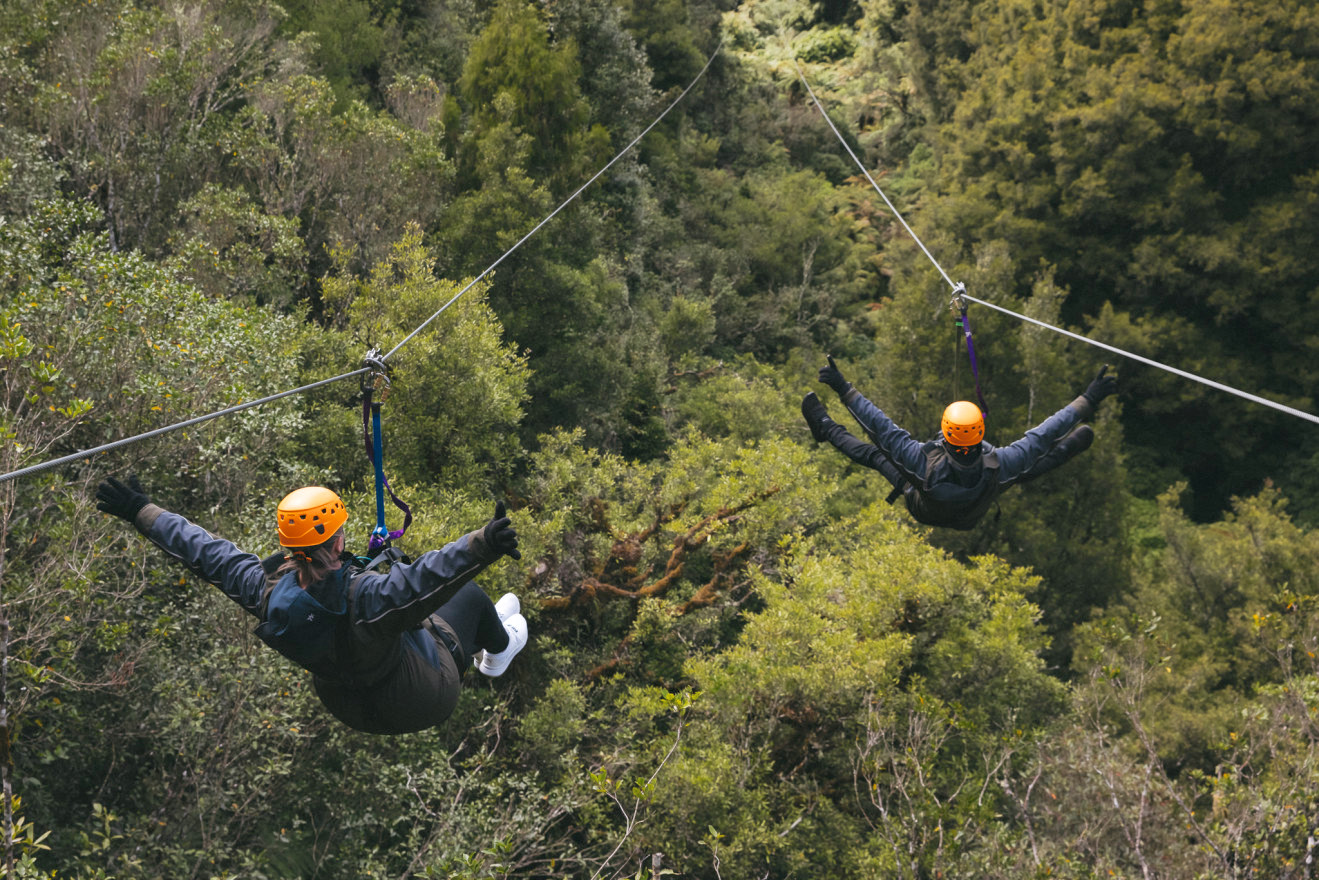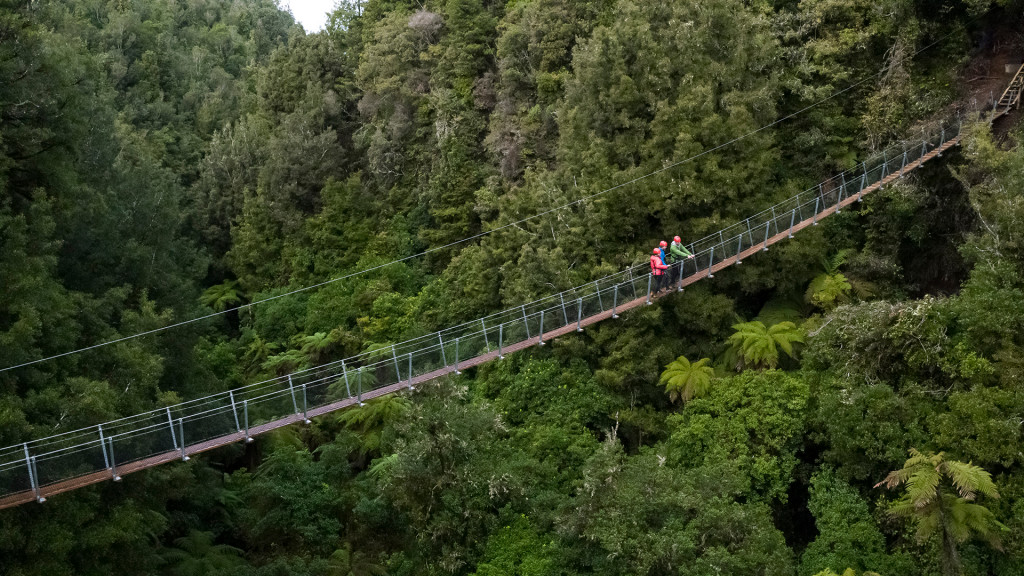
Two participants enjoying the beautiful Dansey Road Scenic Reserve from above. (Photo courtesy of Rotorua Canopy Tours in New Zealand)

Two participants enjoying the beautiful Dansey Road Scenic Reserve from above. (Photo courtesy of Rotorua Canopy Tours in New Zealand)
After donning an orange helmet and clipping into a harness, a step of faith off the platform high above the ground sends one flying through the beautiful canopy of the Dansey Road Scenic Reserve. The zip line is about a quarter of a mile long, but the trip feels like only a few seconds long with greenery rushing by on all sides. The full experience involves repeating this process several more times, along with climbing across swing bridges and repelling down from the final platform. The zip lines here, as well as the beautiful natural surroundings, are managed by Rotorua Canopy Tours, a zip line company located in the smaller city of Rotorua on the North Island of New Zealand.
Rotorua Canopy Tours brands itself as a company heavily invested in ecotourism, which involves more socially conscious forms of tourism that protect the environment, benefit the local communities, and educate the tourists. Ecotourism, when implemented properly, can provide enormous contributions to the environment and the surrounding community. The idea is to create a win-win-win situation: a company thrives, the environment and its inhabitants benefit, and tourists enjoy an informative and thrilling activity.
While ecotourism sounds like a creative solution, it is not a complete panacea. Tourist activities, even if well intentioned, attract more visitors to an area which puts many of these natural wonders under more stress. This increased foot traffic can harm the wildlife directly or even indirectly, through the introduction of invasive species or the altering of animal behavior. Furthermore, when ecotourism is not carried out properly, it can undermine the lives of locals and extensively damage the environment.
Rotorua Canopy Tours has spent over $250,000 NZD (New Zealand Dollars) on sustainability measures in an effort be the best in the ecotourism industry. They’ve devoted much of their workforce to conserving the forest in which it operates by trapping possums, rats, and stoats. While it may sound counterintuitive for conservation to involve trapping, this work is vital to protecting the forest. All three of these species are invasive to the area, have no predators, and also prey on the native bird populations, decimating their numbers and degrading the entire ecosystem.
The company’s approximately 750 traps have culled tens of thousands of pests and restored 280 hectares of forest since trapping started in 2013. Harry Haywood, a senior zip line tour guide for the company, has been working in the tourism and conservation industry for nearly 10 years. He said, “When we started in 2012, we had about 98% saturation of pests in the forest. Nowadays, the possums are around 0.8% saturation. Last I checked, the rats are around 20-22%, but that’s up from around 12%, due to us being in a mast season.” A mast season is a cyclical period when trees drop more nuts and seeds than during a typical year.
_0.jpg)
Evidently, the efforts of Rotorua Canopy Tours provide enormous benefits to the Dansey Road Scenic Reserve, the forest that contains the zip line course and is owned by the New Zealand Department of Conservation. The company’s founders strongly believe in rehabilitating the forest, and according to Haywood, wrote it into their contract with the Department of Conservation. While this agreement helped the founders secure approval to build the zip line course, it also aligned perfectly with their values and mission.
This partnership benefits both sides, as the Department of Conservation allows Rotorua Canopy Tours to operate in the forest in exchange for a lease payment and the trapping work. In fact, Haywood explained that the company’s workforce and funding greatly exceeds the resources the Department of Conservation would have been able to allocate to this forest.
“For me it’s resetting the traps, rebaiting them, and documenting numbers and statistics,” Haywood said of his role in the conservation efforts. “We also work with a local scientific group on various studies and discovered four new species to science, as well as assist in the reintroduction of certain native bird species.”

At the end of the day, the goal of any business is to boost its profits as much as possible, which begs an important question: What responsibilities to the environment do ecotourism companies have?
Many climate activists, business leaders, and philosophers have debated this very question. Brian Berkey and Eric Orts, professors at the University of Pennsylvania’s Wharton School, argue that businesses hold an ethical responsibility to forgo some profit opportunities in order to address the climate crisis because the world cannot sustain current business practices.
The good news is that it does seem intuitive for ecotourism businesses to conserve the places they operate. “It may not necessarily be [a business’] responsibility to look after the country, but they should want to protect the place they are in. If the glaciers are disappearing and the forests are destroyed, then ecotourism businesses won’t make any money either,” said Haywood.
With profits inevitably at the heart of the issue, part of the impetus for companies to change may come from consumers’ choices about where their money goes. Ecotourism remains a viable option for travelers seeking an adventure while minimizing their environmental footprint, but this depends on businesses implementing principles of ecotourism.
At the end of the day, looking out for the environment remains the top priority. “The zip lines are a fun way to get from point A to point B, but you’re really there for the forest,” said Haywood. “You may not realize it until you’re out there, but you’re there for the forest, and seeing it look the way it does partly because of our work feels good.”